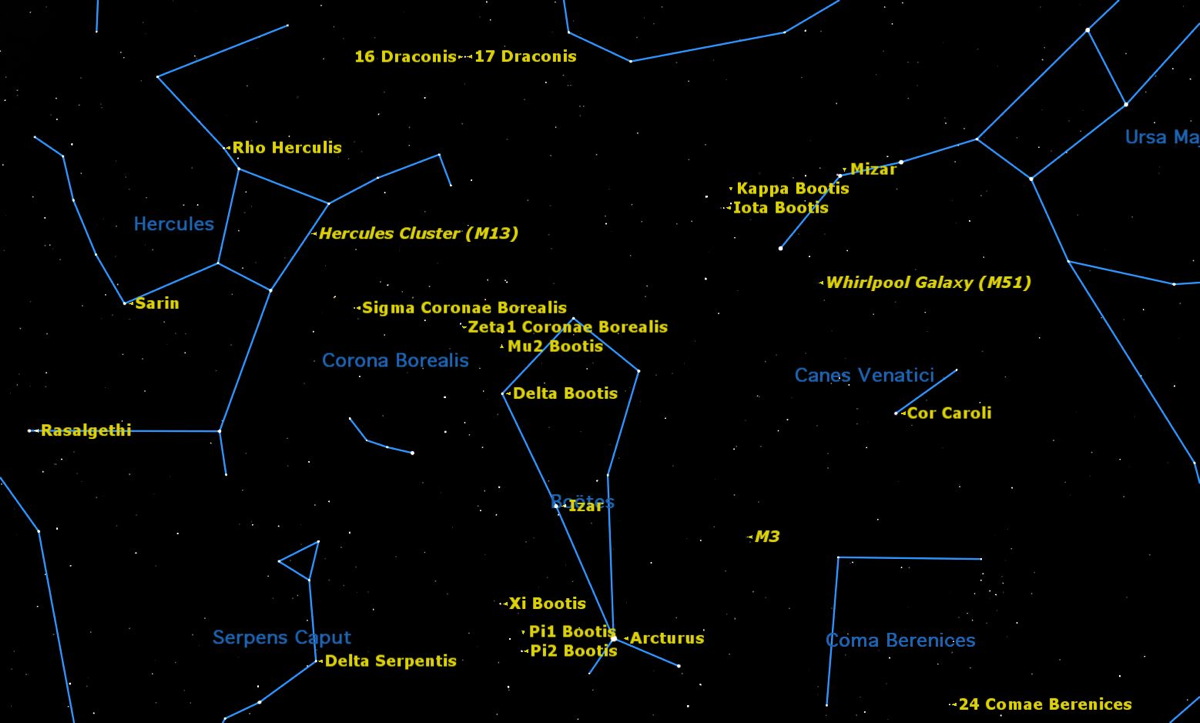See Double Stars in the Night Sky: A 'Starhopping' Guide

On a May evening many years ago, I made my first exploration of the night sky. The only star pattern I could recognize was the Big Dipper, but with a star chart in a book, I used that to discover the bright star Arcturus in the constellation Boötes.
The trick to learning the constellations is to begin with the stars you know, and use them to identify their neighbors. This same technique, known as "starhopping" is the key to discovering all the wonders hidden amongst the stars.
Start, as I did, with the Big Dipper, high overhead as the sky gets dark at this time of year. The stars that form the Dipper's handle fall in a gentle arc, and if you project that arc away from the Dipper’s bowl, you come to a bright star. This is Arcturus, the third brightest star in the night sky, and the brightest star in the northern sky. Only Sirius and Canopus, far to the south, are brighter. [Best Stargazing Events for June (Sky Maps)]
Arcturus is bright in our sky for two reasons, first because it is relatively close to us, 38 light-years away, and secondly because it is inherently a bright star, much brighter than our Sun. Though larger and brighter, it is a slightly cooler star than our Sun, so appears orange to our eyes.
Although Boötes is supposed to be a ploughman in mythology, its pattern of stars most resembles a kite, with Arcturus marking the bottom of the kite where the tail attaches. Notice the little dots over the second "o" in Boötes: this indicates that the two "o"s are supposed to be pronounced separately, as "bow-oo'-tees,” not "boo'-tees."
Once you have identified Boötes, you can use its stars to identify a number of constellations surrounding it. Between it and the Big Dipper are two small constellations, Canes Venatici (the hunting dogs) and Coma Berenices (Bernice's hair). To Boötes left (towards the eastern horizon) is the distinctive keystone of Hercules. Between Hercules and Boötes is Corona Borealis (the northern crown) with Serpens Caput, the head of the serpent, poking up from the south.
Although most stars appear to our unaided eyes as single points of light, anyone with access to binoculars or a telescope soon discovers that nearly half the stars in the sky are either double or multiple stars. Some of these are just accidents of perspective, one star happening to appear in the same line of sight as another, but many are true binary stars: two stars in orbit around each other, similar to the stars which shine on the fictional planet Tatooine in Star Wars.
Get the Space.com Newsletter
Breaking space news, the latest updates on rocket launches, skywatching events and more!
Every star labeled on this map of Hercules, Boötes, and Ursa Major is a double star, worth exploring with a small telescope. Some, like Mizar in the Dipper's handle, can be split with the naked eye. A closer look with a telescope shows that this is really a triple star. Others require binoculars or a small telescope. Some of the finest are Cor Caroli in Canes Venatici, Izar (Epsilon) in Boötes, Delta Serpentis, and Rho Herculis.
One of the joys of double star observing is the color contrasts in some pairs. Others are striking for matching colors and brightness. My favorites are stars of very unequal brightness, which look almost like stars with accompanying planets.
Also marked on this chart are three of the finest deep-sky objects: the globular clusters Messier 13 in Hercules and Messier 3 in Canes Venatici, and the Whirlpool Galaxy, Messier 51, tucked just under the end of the Big Dipper's handle. You will probably need to travel to a dark sky site to spot this galaxy. A 6-inch or larger telescope will begin to reveal its spiral arms, including the one that stretches out to its satellite galaxy, NGC 5195.
Editor's note: If you have an amazing night sky photo you'd like to share for a possible story or image gallery, please contact managing editor Tariq Malik at spacephotos@space.com.
This article was provided to Space.com by Simulation Curriculum, the leader in space science curriculum solutions and the makers of Starry Nightand SkySafari. Follow Starry Night on Twitter @StarryNightEdu. Follow us @Spacedotcom, Facebook and Google+. Original article on Space.com.
Join our Space Forums to keep talking space on the latest missions, night sky and more! And if you have a news tip, correction or comment, let us know at: community@space.com.

Geoff Gaherty was Space.com's Night Sky columnist and in partnership with Starry Night software and a dedicated amateur astronomer who sought to share the wonders of the night sky with the world. Based in Canada, Geoff studied mathematics and physics at McGill University and earned a Ph.D. in anthropology from the University of Toronto, all while pursuing a passion for the night sky and serving as an astronomy communicator. He credited a partial solar eclipse observed in 1946 (at age 5) and his 1957 sighting of the Comet Arend-Roland as a teenager for sparking his interest in amateur astronomy. In 2008, Geoff won the Chant Medal from the Royal Astronomical Society of Canada, an award given to a Canadian amateur astronomer in recognition of their lifetime achievements. Sadly, Geoff passed away July 7, 2016 due to complications from a kidney transplant, but his legacy continues at Starry Night.










